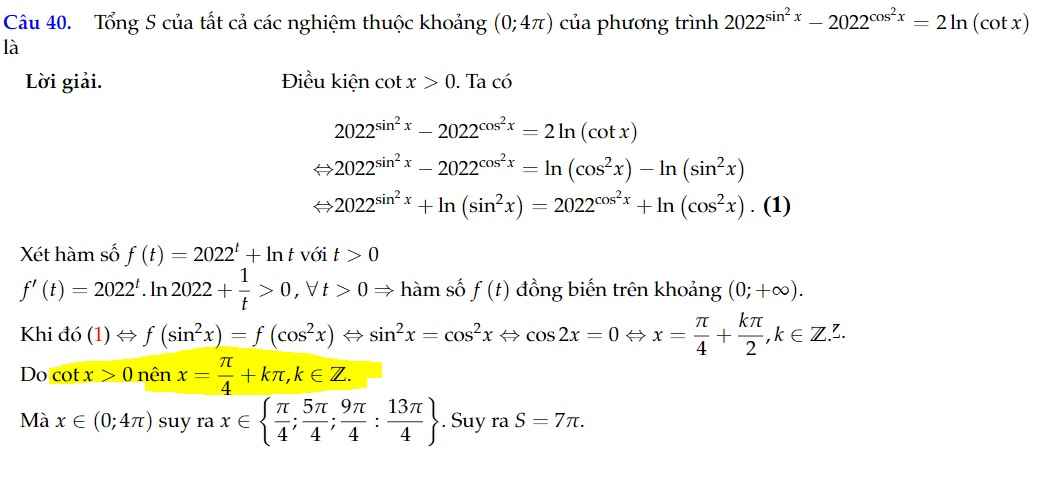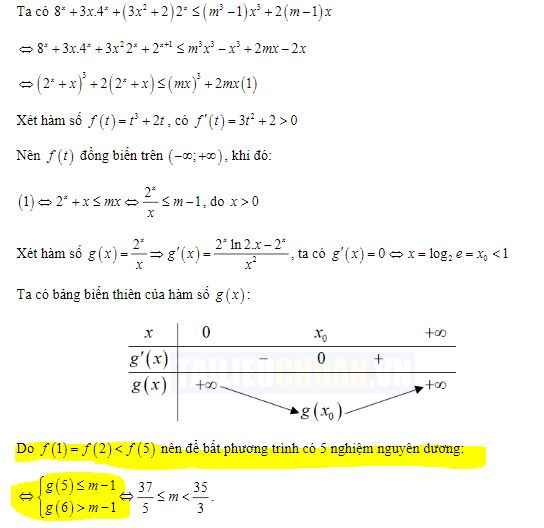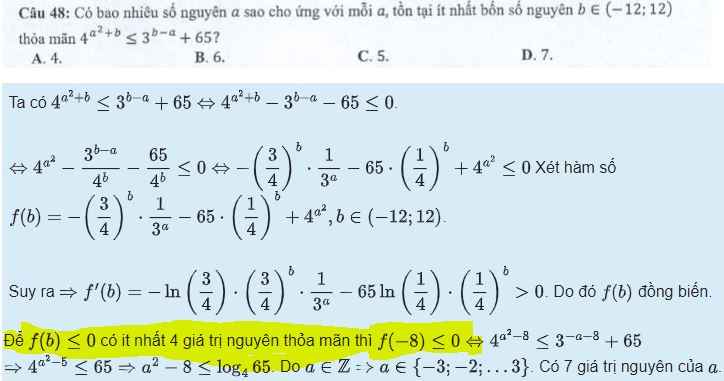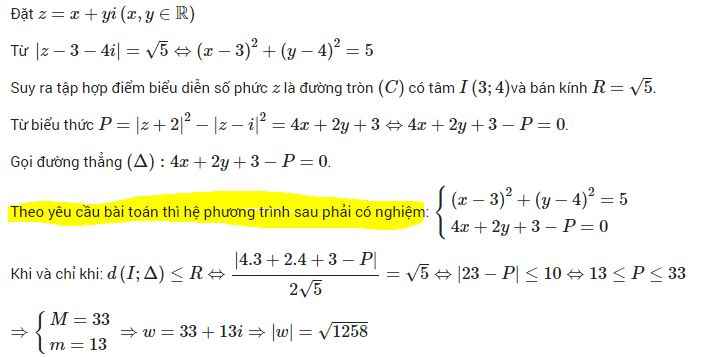Hãy nhập câu hỏi của bạn vào đây, nếu là tài khoản VIP, bạn sẽ được ưu tiên trả lời.

Vì \(f\left(b\right)\) đồng biến nên nếu \(f\left(-8\right)>0\Rightarrow f\left(b\right)>0;\forall b>-8\)
\(\Rightarrow f\left(b\right)\le0\) có nhiều nhất 3 nghiệm nguyên thuộc (-12;12) là -11;-10;-9 (ktm yêu cầu đề bài)
Do đó \(f\left(-8\right)\le0\)
Hiểu đơn giản thì đếm từ -11 trở đi thêm 4 số nguyên ta sẽ chạm tới mốc -8

\(f\left(1-x\right)+f\left(x\right)=\dfrac{9^{1-x}}{9^{1-x}+3}+\dfrac{9^x}{9^x+3}=\dfrac{9}{9+3.9^x}+\dfrac{9^x}{9^x+3}=\dfrac{3}{9^x+3}+\dfrac{9^x}{9^x+3}=1\)
\(\Rightarrow f\left(x\right)=1-f\left(1-x\right)\)
\(\Rightarrow f\left(cos^2x\right)=1-f\left(sin^2x\right)\)
Do đó:
\(f\left(3m+\dfrac{1}{4}sinx\right)+f\left(cos^2x\right)=1\)
\(\Leftrightarrow f\left(3m+\dfrac{1}{4}sinx\right)=f\left(sin^2x\right)\) (1)
Hàm \(f\left(x\right)=\dfrac{9^x}{9^x+3}\) có \(f'\left(x\right)=\dfrac{3.9^x.ln9}{\left(9^x+3\right)^2}>0\Rightarrow f\left(x\right)\) đồng biến trên R
\(\Rightarrow\left(1\right)\Leftrightarrow3m+\dfrac{1}{4}sinx=sin^2x\)
Đến đây chắc dễ rồi, biện luận để pt \(sin^2x-\dfrac{1}{4}sinx=3m\) có 8 nghiệm trên khoảng đã cho

1.a/ \(\left\{{}\begin{matrix}3^{x+1}>0\\5^{x^2}>0\end{matrix}\right.\) \(\forall x\) \(\Rightarrow\) pt vô nghiệm
b/ Mình làm câu b, câu c bạn tự làm tương tự, 3 câu này cùng dạng
Lấy ln hai vế:
\(ln\left(3^{x^2-2}.4^{\dfrac{2x-3}{x}}\right)=ln18\Leftrightarrow ln3^{x^2-2}+ln4^{\dfrac{2x-3}{x}}-ln18=0\)
\(\Leftrightarrow\left(x^2-2\right)ln3+\dfrac{2x-3}{x}2ln2-ln\left(2.3^2\right)=0\)
\(\Leftrightarrow x^3ln3-2x.ln3+4x.ln2-6ln2-x.ln2-2x.ln3=0\)
\(\Leftrightarrow x^3ln3-4x.ln3+3x.ln2-6ln2=0\)
\(\Leftrightarrow x.ln3\left(x^2-4\right)+3ln2\left(x-2\right)=0\)
\(\Leftrightarrow\left(x-2\right)\left(x^2ln3+2x.ln3+3ln2\right)=0\)
\(\Rightarrow\left[{}\begin{matrix}x-2=0\Rightarrow x=2\\x^2ln3+2x.ln3+3ln2=0\left(1\right)\end{matrix}\right.\)
Xét (1): \(\left(x^2+2x\right)ln3=-3ln2\Leftrightarrow x^2+2x=\dfrac{-3ln2}{ln3}=-3log_32\)
\(\Leftrightarrow\left(x+1\right)^2=1-3log_32=log_33-log_38=log_3\dfrac{3}{8}< 0\)
\(\Rightarrow\left(1\right)\) vô nghiệm
\(\Rightarrow\) pt có nghiệm duy nhất \(x=2\)
2/ Pt đã cho tương đương:
\(2017^{sin^2x}-2017^{cos^2x}=cos^2x-sin^2x\)
\(\Leftrightarrow2017^{sin^2x}+sin^2x=2017^{cos^2x}+cos^2x\)
Xét hàm \(f\left(t\right)=2017^t+t\) (\(0\le t\le1\))
\(\Rightarrow f'\left(t\right)=2017^t.ln2017+1>0\) \(\forall t\) \(\Rightarrow f\left(t\right)\) đồng biến
\(\Rightarrow f\left(t_1\right)=f\left(t_2\right)\Leftrightarrow t_1=t_2\)
\(\Rightarrow sin^2x=cos^2x\Rightarrow cos^2x-sin^2x=0\Rightarrow cos2x=0\)
\(\Rightarrow x=\dfrac{\pi}{4}+\dfrac{k\pi}{2}\)
Thế k=0; k=1 ta được 2 nghiệm thuộc đoạn đã cho là \(x=\dfrac{\pi}{4};x=\dfrac{3\pi}{4}\)
\(\Rightarrow\) tổng nghiệm là \(T=\dfrac{\pi}{4}+\dfrac{3\pi}{4}=\pi\)

Có thể đưa về hàm số:
\(AB=2\Rightarrow MB=\sqrt{AB^2-MA^2}=\sqrt{4-MA^2}\)
Đặt \(MA=t\) với \(0\le t\le2\) \(\Rightarrow MB=\sqrt{4-t^2}\)
\(P=MA+2MB=f\left(t\right)=t+2\sqrt{4-t^2}\)
Xét hàm \(f\left(t\right)\) trên \(\left[0;2\right]\)
\(f'\left(t\right)=1-\dfrac{2t}{\sqrt{4-t^2}}=0\Rightarrow2t=\sqrt{4-t^2}\Rightarrow5t^2=4\Rightarrow t=\dfrac{2}{\sqrt{5}}\)
\(f\left(0\right)=4\) ; \(f\left(2\right)=2\) ; \(f\left(\dfrac{2}{\sqrt{5}}\right)=2\sqrt{5}\)
\(\Rightarrow f\left(t\right)_{max}=2\sqrt{5}\Rightarrow P_{max}=2\sqrt{5}\)

Không biết em có làm sai không:
ĐKXĐ: \(x,y\ge0\).
Đặt 2x = a; 3y = b.
HPT trở thành:
\(\left\{{}\begin{matrix}\left(\sqrt{5}\right)^a-\left(\sqrt{5}\right)^b+\left(a-b\right)\left(ab+12\right)=0\\a^2+b^2=16\end{matrix}\right.\)
\(\Leftrightarrow\left\{{}\begin{matrix}a^2+b^2=16\\\left(\sqrt{5}\right)^a-\left(\sqrt{5}\right)^b+\left(b-a\right)\left(a^2+b^2\right)+a^3-b^3+12\left(a-b\right)=0\end{matrix}\right.\)
\(\Leftrightarrow\left\{{}\begin{matrix}a^2+b^2=16\\\left(\sqrt{5}\right)^a+a^3-4a=\left(\sqrt{5}\right)^b+b^3-4b=0\left(1\right)\end{matrix}\right.\).
Giả sử \(a\ge b\Rightarrow\left(\sqrt{5}\right)^a\ge\left(\sqrt{5}\right)^b\). Mà \(\left(a^3-4a\right)-\left(b^3-4b\right)=\left(a-b\right)\left(a^2+ab+b^2-4\right)\ge0\) nên VT(1) \(\ge\) VP(1).
Do đẳng thức xảy ra nên ta có a = b. Thay vào ta tìm được a = b = \(2\sqrt{2}\) nên \(x=\sqrt{2};y=\dfrac{2\sqrt{2}}{3}\).
\(\left\{{}\begin{matrix}\left(\sqrt{5}\right)^{2x}-\left(\sqrt{5}\right)^{3y}=\left(3y-2x\right)\left(6xy+12\right)\left(1\right)\\4x^2+9y^2=16\left(2\right)\end{matrix}\right.\)
\(\left(2\right)\Rightarrow4x^2+9y^2-4=12\) the vo (1)
\(\Rightarrow\left(\sqrt{5}\right)^{2x}-\left(\sqrt{5}\right)^{3y}=\left(3y-2x\right)\left(6xy+4x^2+9y^2-4\right)\)
\(\Leftrightarrow\left(\sqrt{5}\right)^{2x}-\left(\sqrt{5}\right)^{3y}=27y^3-8x^3-12y+8x\)
\(\Leftrightarrow\left(\sqrt{5}\right)^{2x}+\left(2x\right)^3-4.\left(2x\right)=\left(\sqrt{5}\right)^{3y}+\left(3y\right)^3-4.\left(3y\right)\left(3\right)\)
Xét hàm số \(f\left(t\right)=\left(\sqrt{5}\right)^{2t}+\left(2t\right)^3-4.2t\) đồng biến trên R
\(\Rightarrow\left(3\right):f\left(2x\right)=f\left(3y\right)\Leftrightarrow\left\{{}\begin{matrix}2x=3y\\4x^2+9y^2=16\end{matrix}\right.\Leftrightarrow\left\{{}\begin{matrix}x=\sqrt{2}\\y=\dfrac{2\sqrt{2}}{3}\end{matrix}\right.\)

Mọi điểm M biểu diễn z đều phải thỏa mãn 2 điều kiện: vừa thuộc đường tròn (C) vừa thuộc đường thẳng \(\Delta\) (tham số P)
Do đó, M là giao điểm của (C) và \(\Delta\)
Hay tham số P phải thỏa mãn sao cho (C) và \(\Delta\) có ít nhất 1 điểm chung
Hay hệ pt nói trên có nghiệm (thật ra chi tiết đó là thừa, chỉ cần biện luận (C) và \(\Delta\) có ít nhất 1 điểm chung \(\Rightarrow d\left(I;\Delta\right)\le R\) là đủ)






